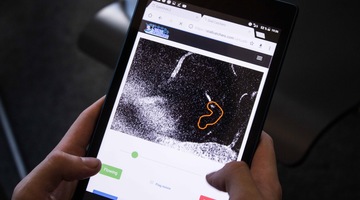Antonia Hoeta and Dr Karyn Maclennan came up with a novel way to engage young people with science information and help dispel misinformation and disinformation about viruses and vaccines.
Questions for discussion
- Antonia believes that gaming is the best way to get information across to people. What do you think about this method?
- Which game idea appeals to you? Why?
Transcript
Dr Karyn Maclennan
We became very aware during the COVID-19 pandemic that rangatahi and their whānau really needed accessible information that was grounded in science rather than mis- or disinformation, and so we wanted to think of a way of really engaging young people in scientific facts about viruses and vaccines that could be shared with others in a fun way grounded in science.
Omar
See this is the first level – this maze is like the blood vessels.
Antonia Hoeta
You’re building a maze – how cool.
Dr Karyn Maclennan
Toni at Otago Museum came up with the idea of doing a digital game design challenge to inform and to inspire tamariki and rangatahi around year 5 to year 10. Young people are the experts in what is going to be relevant and engaging to other children. We really wanted to use their ideas to create a game that is going to teach about viruses and vaccines but also be super fun to play at the same time.
Antonia Hoeta
I pitched the idea to Karyn of doing it in some sort of gaming sense, because I’m a gamer and I have a huge interest in viruses. I did microbiology in uni, and I just like the processes of how the vaccine was actually created and helping kids understand the science behind it so that they’re not scared as well.
The main learning outcome that we wanted to get across was what viruses are and how they mutate, so when kids hear it on the news, they can hear, “Oh, there’s a new strain out.” They understand that it’s the spike proteins of the virus, and the spike proteins is how it attaches to the cell. So I wanted them to have a firm understanding of the science behind it. And usually when kids go home, they talk to their parents, you know – they’re getting that information, they’re passing it on to their whānau as well.
And kids are brilliant. We underestimate them. Rolling out education programmes is one of the most effective ways to get hard sciences across to the public, because you can’t roll out an entire mandate without having the trust of your community behind you. And you have the trust if you explain the science in a way that doesn’t make people feel dumb. And the best way to do that is by playing actually.
Raewyn Glenn
Callum likes gaming like most kids. When he does actually have something physically to work with, he has great ideas.
Callum
I came up with a world where viruses have taken over and the last doctor in the world has to travel on a quest to defeat it.
Antonia Hoeta
We wanted a hands-on aspect because not all kids are into digital stuff, and even the ones that are into digital things don’t know how creative they are until they get their hands in and start just putting things together. And it’s like, everybody loves clay – hands-on clay making and diorama building – so that the kids’ stories could have both a physical and a digital aspect.
Anya
This is my map and my main character, White Blood Cell, and these are the Mafia Boss’s minions. So they’re small little viruses, which can be gobbled up by the White Blood Cell, mmm nom. But once this White Blood Cell collects an antibody, nom, he’ll be powerful enough to take down the Mafia Boss – the big virus.
Antonia Hoeta
The physical building of the clay models and dioramas sparked the learning just because they need to know the structure of how things are. They can put their own flair into it. It could be a fruit virus, but how would that virus look if it’s gonna be grounded in some science?
Isla
This one is an octopus, and then it gives little vaccines out of its tentacles to bad viruses. I thought it looks really cool when you could see the viruses moving. It gave you an idea what your virus would move like in the game.
Omar
I like building stuff, and when I do clay I build stuff. And in games, I also build stuff. That’s what I like the most. When I’m making games. I like modelling the environment and the characters. When I started making this game, I felt like I was starting to know more about viruses and like the body.
Acknowledgements
Dr Karyn Maclennan, Te Roopū Rakahau Hauora Māori o Kāi Tahu | Ngāi Tahu Māori Health Research Unit, University of Otago
Omar
Antonia Hoeta, Tūhura Otago Museum
Raewyn Glynn
Callum
Anya
Isla
Mila
Community and school engagement images, D-BUG Game Design Challenge flyer and information sheets, courtesy of The Science of Medicines with thanks to Green Grubs Design for some design work and Annah for use of some illustrative elements



